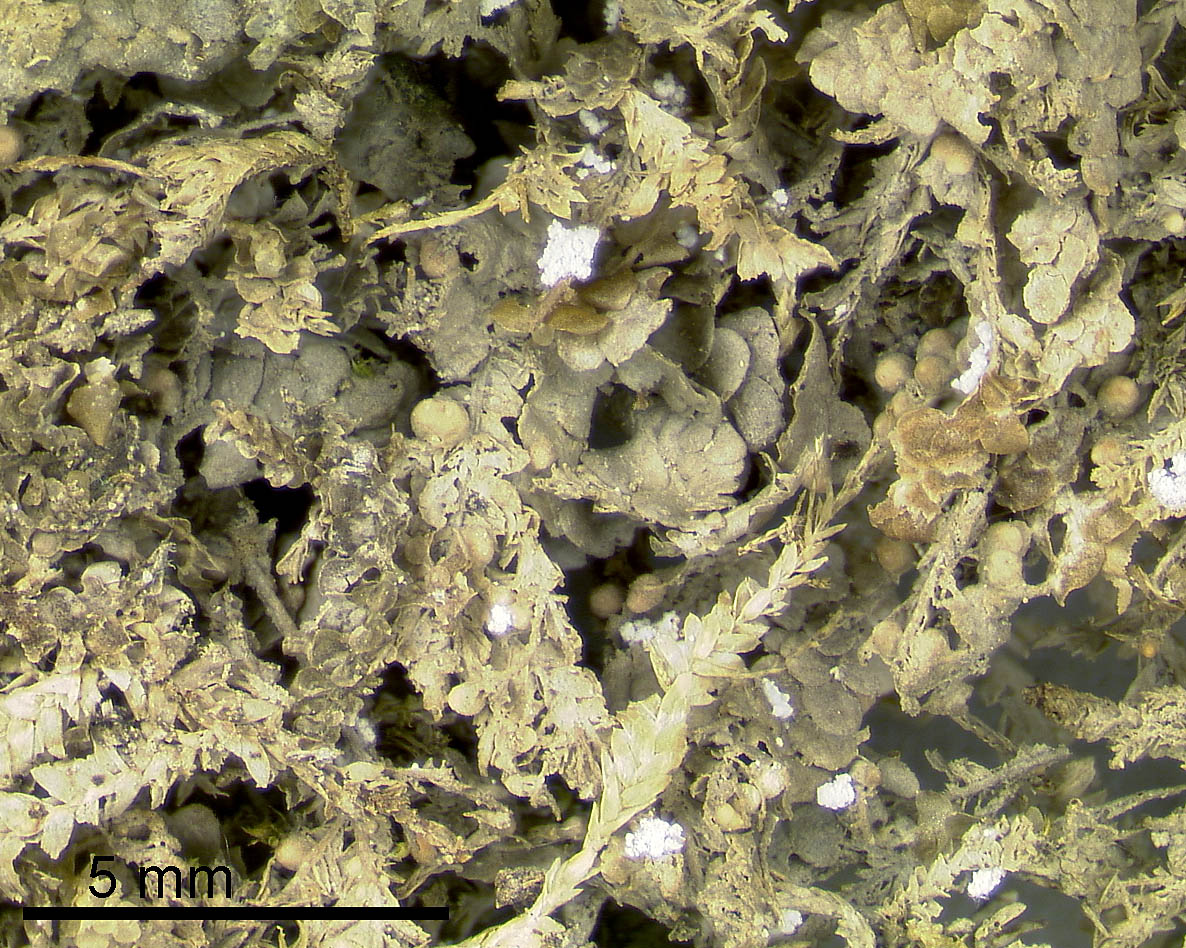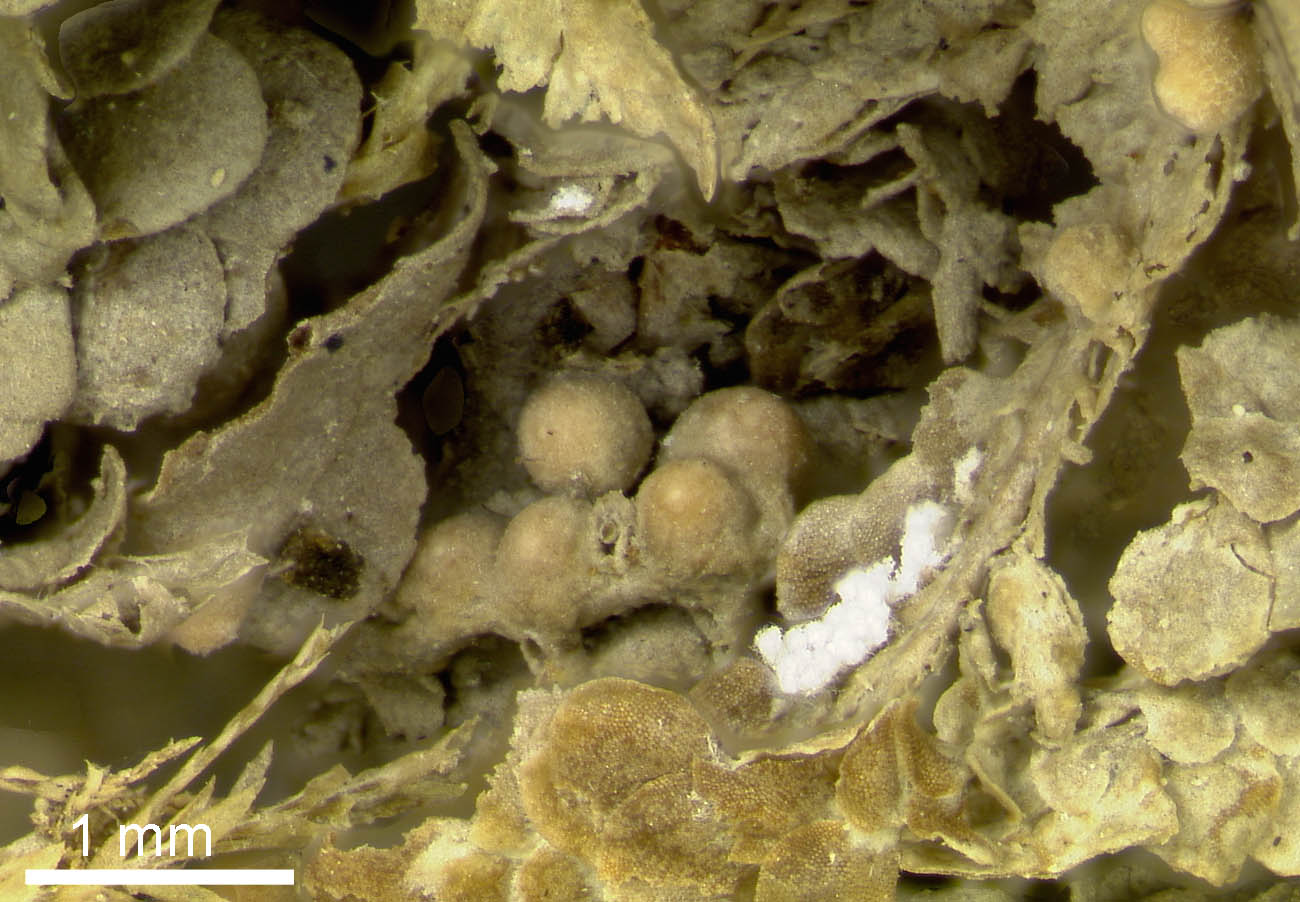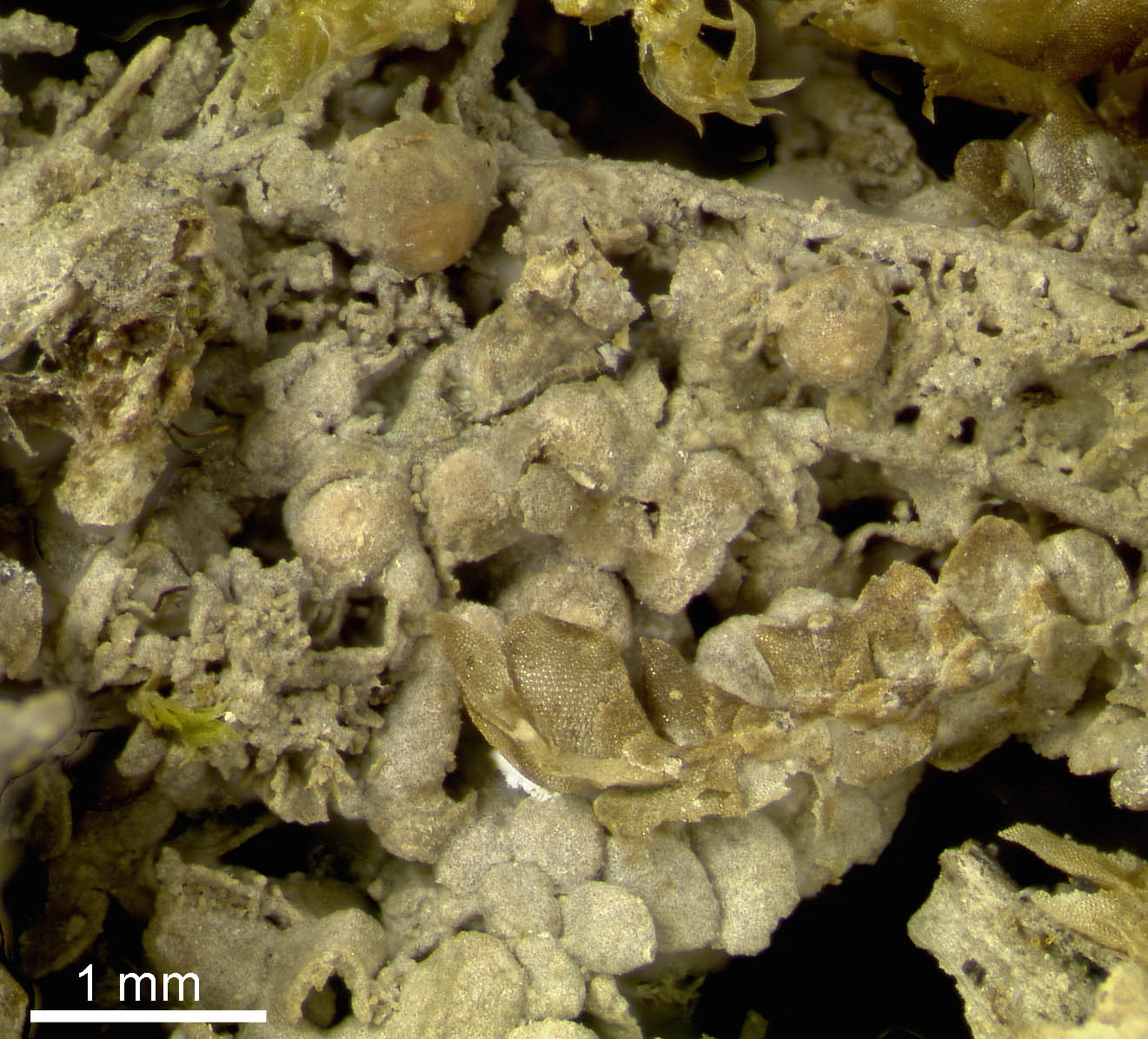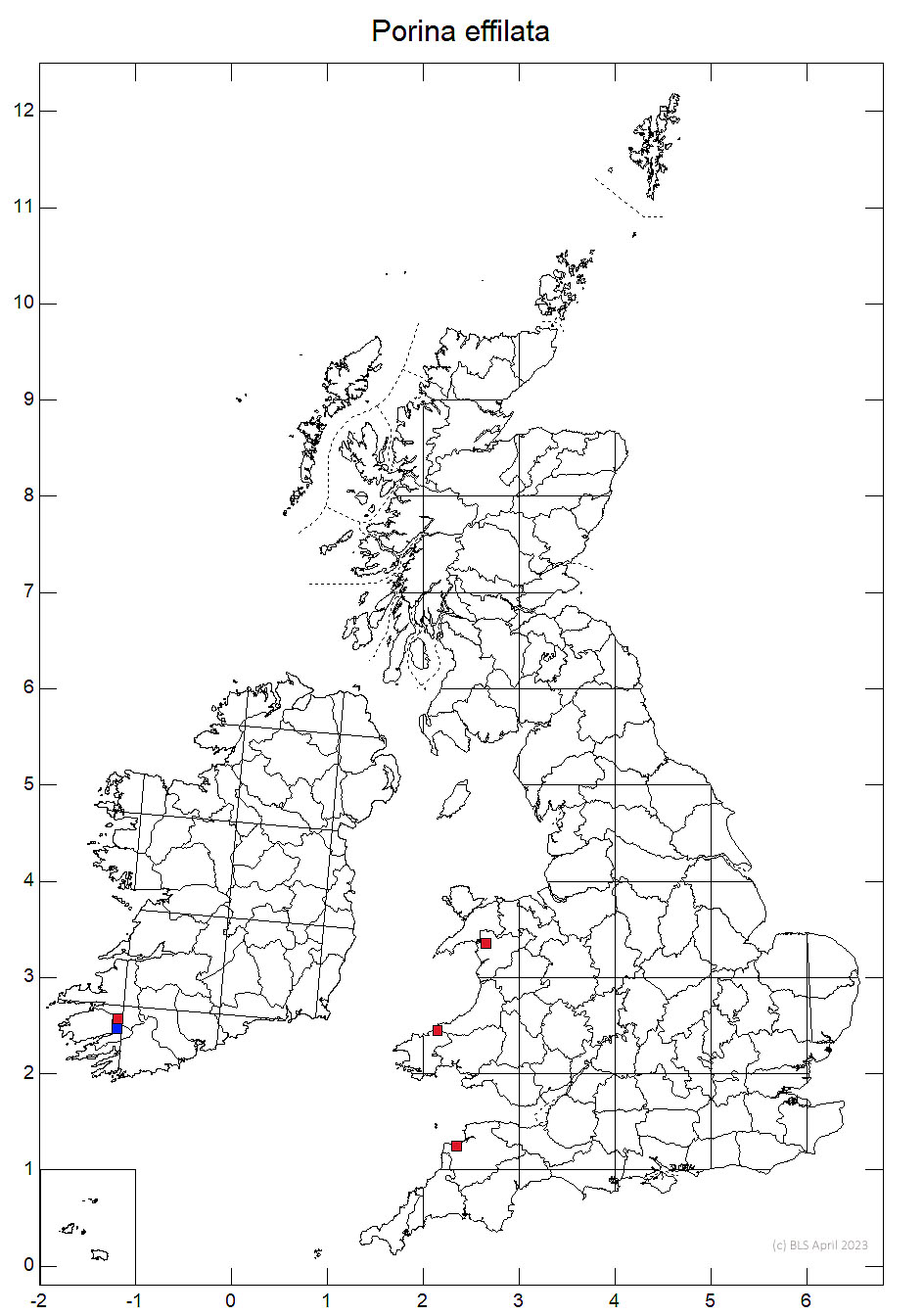synonyms
Porina atlantica auct. p.p.
P. guaranitica auct., p.p.
P. heterospora auct., p.p.
P. nucula auct., p.p.
Common Name(s)
None
Description & Identification
This rare pyrenocarpous lichen overgrows bryophytes on base-rich bark and rock in mild oceanic parts of the British Isles. The thallus is pale orange or pinkish when fresh (containing Trentepohlia), turning pale grey or grey-green in the herbarium, and forming a thin smooth layer over bryophytes. There are no isidia. The perithecia are large, mostly 400-900 µm diameter, coloured like the thallus or pale pink-brown or pale yellow-brown, never with dark pigments. The perithecia are usually easily seen, forming hemispherical projections, but can sometimes be immersed in the thallus. In section the perithecium has only yellow pigment; the ascospores are long and
narrow, 40-90 × 8-12 µm, and transversely 7-14-septate.
The occurrence of this species in Wales is likely to be limited by two factors, among others: the need for base-rich rock or bark, and a presumed requirement for mild, oceanic conditions. Even at the two known Welsh sites, suitable calcareous rock is scarce. Thus the Welsh population is always likely to be small, although the species
could still be found on sufficiently base-rich bark.
The species has been confused with several others, and most records originally appeared under other names.
 |
 |
 |
Photos: Alan Orange |
Similar Species
Belonia russula also has a trentepohlioid photobiont, but the thallus is coarser and cracked, the ascospores are only 3-6 µm wide, and it grows directly on rock in upland overhangs.
Porina ahlesiana has smaller perithecia, 300-500(-700) µm diameter, ascospores 30-50(-70) × 6-9(-15) µm, (6-)7-septate, and grows directly on rock.
Porina atlantica (Ireland; not known from Wales) usually has isidia on the thallus, and the involucrellum covering the perithecium contains numerous large crystals, which are absent in P. effilata.
Thelenella muscorum may also grow on bryophytes on bark and rock, but the thallus is whitish or pale brown, with a green (not orange) photobiont, the perithecia are smaller (300-600 µm diameter) and typically immersed in the substratum, and the ascospores are muriform.
Habitats
Throughout its range mainly on bark, often overgrowing bryophytes, in good-quality habitats. The record from North Devon is on the mossy bark of an oak. The two Welsh records are on bryophytes on steep, slightly calcareous outcrops of siliceous rock in woodland; associated species include the bryophytes Marchesinia mackaii,
Metzgeria furcata and Neckera complanata, and the lichens Enterographa zonata and Verrucaria elaeina.
Distribution
In the British Isles it is known only from SW Ireland (North Kerry and West Cork), W Wales (2 sites), and from a single site on the North Devon coast. Elsewhere known only from Portugal, Canary Islands and Madeira.
Records from Wales
V.C. 46 (Cardigan). Coedmor National Nature Reserve, SE of Coedmore House, 22/195.432, on bryophytes on vertical rock face sheltered by ivy, 20 March 1996, A. Orange 10998 (NMW - C97.35.657) [originally as P. heterospora].
V.C. 48 (Merioneth). Bryn Bwbach, Ceunant Coch, 23/6295.3642, on slightly calcareous rock face in woodland, 4 May 2002, A. Orange 13840 (NMW - C.2002.017.48) [originally as P. atlantica].
Notes on individual locations
At Coedmor NNR P. effilata grew on a well-lit outcrop on the north side of the Teifi gorge, directly opposite Cilgerran Castle on the south side. This outcrop had a remarkable assemblage of usually corticolous old-forest species including Mycobilimbia pilularis (Biatora sphaeroides), Nephroma laevigatum (abundant),
Parmeliella parvula (rare), Sticta canariensis (frequent), S. limbata (rare) and Porina rosei. This rock face is in Compartment 9 of the NNR, near the top of the steep valley side, and is best accessed from the field above the reserve.
In Merioneth P. effilata was recorded on a slightly calcareous cliff in woodland with a
high degree of ecological continuity. The site was privately owned.
Threats and Status
Potential threats include excessive shading from ivy, brambles or trees, and loss of ancient trees. In Britain, this species is Critically Endangered and Nationally Rare. Endangered in Wales.
Proposed Actions
The site at Coedmor should be revisited to check whether shading from ivy and saplings is taking place, and to remove them if necessary.
UK BAP Actions 2008
1. Monitor habitat condition and species, at least every 6 years, at extant sites to ensure that the management (of grazing levels) maintains continuity of veteran trees, current light and humidity levels and that the population is not subjected to over-shading (e.g. Ivy, Rhododendron ponticum) and modify accordingly.
2. Encourage survey of suitable ancient woodland sites (rocks and trees) within expected range and incorporate new sites into the monitoring and protection framework.
NBN Taxon Key
NHMSYS0020039039
References
Orange, A. (2003) A Lichen Survey of the Oakwoods of Meirionnydd and Dwyfor
(North Wales). National Museum of Wales, Report to Countryside Council for
Wales,Contract number FC 79-01-10. [Section 27. Eisengrug].
Orange, A. & Wolseley, P. (1996) Survey and Monitoring of Lichens at Coedmor
National Nature Reserve. Report to Countryside Council for Wales.
Sérusiaux, E., Berger, F., Brand, M. & van den Boom, P. (2007) The lichen genus
Porina in Macaronesia, with descriptions of two new species. Lichenologist 39:
15-33.
- Log in to post comments

